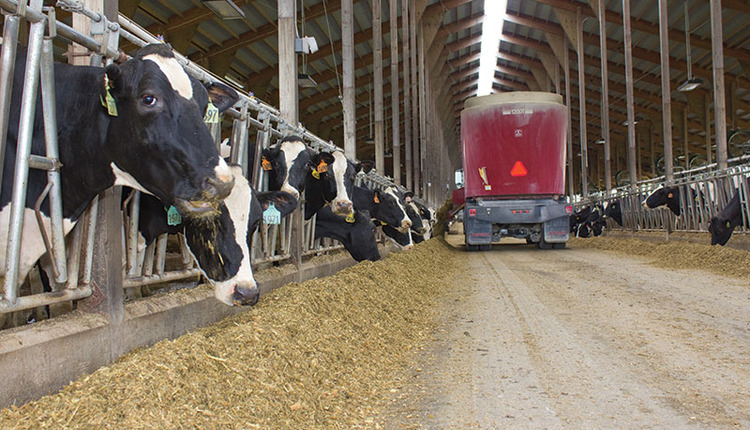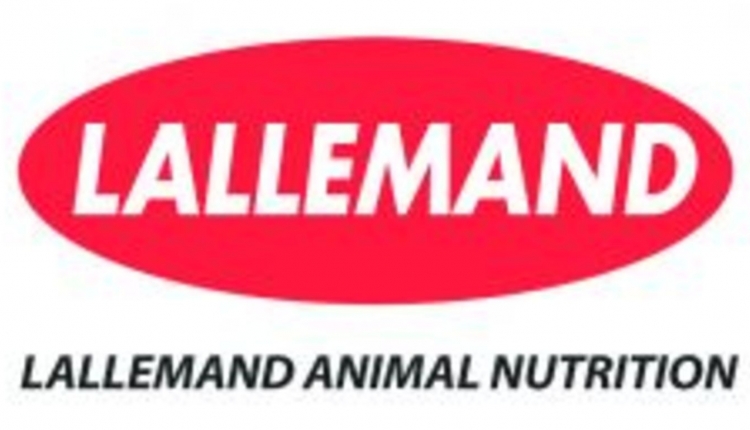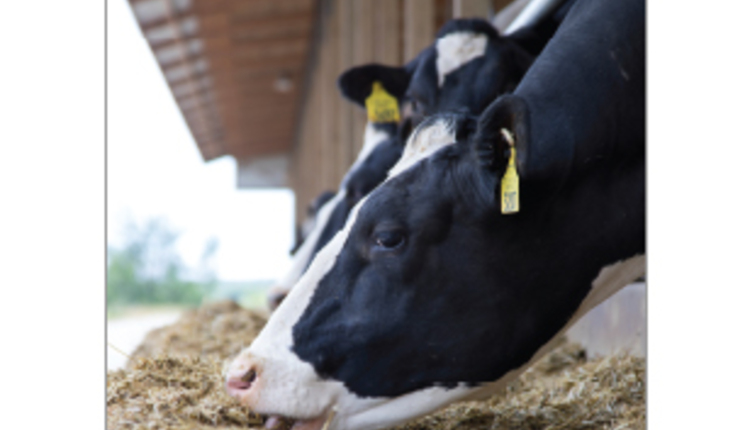
The author is an extension dairy specialist at the University of Illinois, Champaign-Urbana.
Feed additives are ingredients added for a non-nutrient role. (For example, sodium bicarb is added as a rumen buffering agent, not a source of sodium.) Additives vary in cost from 3 to 30 cents a cow a day. The main reason to add a feed additive is to enhance cow performance based on farm conditions, research results, the additive's role, and economic returns.
Here, I outline additives in six categories that may help you and your advisors decide if an additive should be included.
The category, current status, is classified in the following ways.
Recommended: Include as needed.
Experimental: Additional research is needed before recommending.
Evaluative: Monitor individual farm situation (there will be variable responses).
Not recommended: Currently lacks economic response.
[Anionic salts and products]
1. Function: Cause the diet to be more acidic-boosting blood calcium levels by stimulating bone mobilization of calcium and calcium absorption from the small intestine.
2. Level: Reduce DCAD to 0 to -50 meq/kg or 5 meq/100 grams using chloride sources (such as calcium chloride, ammonium chloride, Bio Chlor, Animate, Soy Chlor, Nutra Chlor, and hydrochloric acid-treated feeds).
3. Cost: 40 to 75 cents per dry cow per day.
4. Benefit-to-cost ratio: 10:1.
5. Feeding strategy: Feed to dry cows two to three weeks before calving. Adjust dietary calcium levels to 100 grams per day (30 grams inorganic). Raise dietary magnesium levels to 0.4 percent.
6. Status: Recommended.
[Aspergillus oryzae]
1. Function: Stimulate fiber-digesting bacteria, stabilize rumen pH, and reduce heat stress.
2. Level: 3 grams per day
3. Cost: 3 cents per cow per day.
4. Benefit-to-cost ratio: 6:1.
5. Feeding strategy: High-grain diets, low rumen pH conditions, and under-heat-stress (cows) and calves receiving a liquid diet.
6. Status: Evaluative.
[Biotin]
1. Function: Improve hooves by reducing heel warts, claw lesions, white line separations, sand cracks, and sole ulcers, and improve milk yield through metabolic routes.
2. Level: 10 to 20 milligrams per cow per day for six months to one year.
3. Cost: 8 to 10 cents per cow per day.
4. Benefit-to-cost ratio: 4:1.
5. Feeding strategy: Herds with chronic foot problems may require supplementation for six months before evaluation. Company recommends beginning supplementation at 15 months of age.
6. Status: Recommended.
[Beta-carotene]
1. Function: Improve breeding with higher ovarian levels, fiber digestion by rumen microbes, immune response, and mastitis control.
2. Level: 300 mg per day (blood levels 1.5 to 3.5 micrograms/ml); 500 mg per day (blood levels <1.5 micrograms per ml).
3. Cost: 30 to 50 cents per cow per day.
4. Benefit-to-cost ratio: Not available.
5. Feeding strategy: In early lactation and during mastitis-prone time periods.
6. Status: Experimental.
[Calcium propionate]
1. Function: Raise blood glucose and calcium.
2. Level: 120 to 225 grams.
3. Cost: 80 cents per pound.
4. Benefit-to-cost ratio: Not available.
5. Feeding strategy: Feed between seven days before calving to seven days after or until appetite responds. Unpalatable.
6. Status: Recommended as a drench agent.
[Choline (rumen protected)]
1. Function: A methyl donor used to minimize fatty liver formation and to improve fat mobilization leading to improved milk yield and breeding.
2. Level: 15 to 30 grams per day.
3. Cost: 30 cents per cow per day.
4. Benefit-to-cost ratio: 2:1 (when protected).
5. Feeding strategy: Feed between two weeks before calving to eight weeks after to cows experiencing ketosis, weight loss, and high milk yield.
6. Status: Recommended.
[Enzymes (fibrolytic)]
1. Function: Improve fiber digestibility by breaking down fiber and helping intakes.
2. Level: Not clearly defined (enzymatic units per unit of feed dry matter).
3. Cost: 15 to 30 cents per cow per day.
4. Benefit-to-cost ratio: 2 to 3:1 (Canadian data).
5. Feeding strategy: Improve fiber digestibility, treated 12 hours before feeding, spray- on product more effective when applied to dry diets. May be diet specific.
6. Status: Experimental.
[Enzymes (starch-amylase)]
1. Function: Amylase-based enzymes can improve total tract starch digestibility and improve milk yield and feed efficiency.
2. Level: 300 kNU per kg dry matter intake. 1 kNU = approx 6 "Ceralpha Units" using the Megazyme International amylase assay.
3. Cost: 15 cents per day.
4. Benefit-to-cost ratio: 3:1 (U of WI data).
5. Feeding strategy: Improve starch utilization reducing corn levels needed and replacing it with lower cost rumen fermentable carbohydrate sources.
6. Status: Experimental.
[Essential oil compounds (cinnamon oil, clove oil, and/or garlic oil)]
1. Function: Improve rumen fermentation by reducing protein deamination, raise propionate production, improve feed efficiency, and/or improve hydrogen status.
2. Level: 0.5 to 1.5 grams per cow per day (higher levels may have a negative impact.
3. Cost: Varies, 6 cents per cow per day .
4. Benefit-to-cost ratio: 7:1 (Wisconsin data).
5. Feeding strategy: Increase propionate production in the rumen and feed efficiency.
6. Status: Experimental.
[Immune stimulation (OmniGen AF-brand name)]
1. Function: Impacting immune function as measured by changes in neutrophil activity, including migration via L-selectin, phagocytosis, oxidative burst reactions leading to lower SCC and higher milk yield because of immunity improvement. May be used to reduce hemorrhagic bowel or bloody gut losses.
2. Level: 56 grams per day.
3. Cost: 13 cents per day.
4. Benefit-to-cost ratio: 7:1 early lactation; 3:1 for entire lactation.
5. Time period: Dry-off to 60 days after calving.
6. Status: Experimental.
[Magnesium oxide]
1. Function: Alkalinizer (raises rumen pH) and improves uptake of blood metabolites by the mammary gland raising fat test.
2. Level: 45 to 90 grams per day.
3. Cost: 21 cents per pound.
4. Benefit-to-cost ratio: Not available.
5. Feeding strategy: With sodium-based buffers (ratio of two to three parts sodium bicarbonate to one part magnesium oxide).
6. Status: Recommended as a source of magnesium and buffer pack with bicarb.
[Methionine hydroxy analog]
1. Function: Minimize fatty liver formation, control ketosis, and improve milkfat test.
2. Level: 30 grams.
3. Cost: 10 cents per cow per day ($1.60 per pound).
4. Benefit-to-cost ratio: 2:1.
5. Feeding strategy: Feed to cows in early lactation receiving high levels of concentrate and limited dietary protein.
6. Status: Evaluative.
[Monensin (Rumensin - brand name)]
1. Function: Improve feed efficiency for cows in milk, reduce ketosis and displaced abomasums in transition cows by shifting rumen fermentation and microbial selection. Milk yield may go up 2.2 pounds per day. Control cocci in calves and heifers.
2. Level: 11 to 22 grams per ton of total ration dry matter consumed (250 to 400 mg/cow/day). Lower levels in calves and heifers.
3. Cost: 1 cent per 100 mg per day.
4. Benefit-to-cost ratio: 5 to 1.
5. Feeding strategy: Feed to dry cows to reduce metabolic disorders and to milking cows for feed efficiency while monitoring milk components to evaluate optimal levels of monensin.
6. Status: Recommended.
[Niacin (B3, nicotinic acid, and nicotinamide)]
1. Function: Coenzyme in biological reactions, improve energy balance in early-lactation cows, control ketosis, and stimulate rumen protozoa.
2. Level: 6 grams unprotected per cow (before calving), 12 grams unprotected per cow (after calving), or 3 grams of rumen protected (1 gram of rumen protected replaces 8 grams of unprotected niacin) and 3 grams of unprotected for rumen function.
3. Cost: One cent per gram unprotected; 10 cents rumen protected.
4. Benefit-to-cost ratio: 3:1 (12 grams level).
5. Feeding strategy: High-producing cows in negative energy balance, heavy dry cows, and ketotic-prone cows fed two weeks before calving to peak dry matter intake (10 to 12 weeks after calving).
6. Status: Evaluative.
[Prebiotics (Nonviable probiotics)]
1. Function: Stimulate bacterial growth or reduce bacteria growth that can reduce animal performance. Examples include inulin (stores carbohydrates), oligofructose, yeast cell wall products, mannan oligosaccharide (MOS) products, butyrate (0.16 g/liter of milk), lactoferrrin (2 mg/ml of colostrum).
2. Level: Varies by product and brand.
3. Cost: 4 to 15 cents per day.
4. Benefit-to-cost ratio: Not available.
5. Feeding strategies: Feed to calves and animals exposed to undesirable bacteria in the digestive tract.
6. Status: Experimental.
[Probiotics (Bacterial direct-fed microbes)]
1. Function: Produce metabolic compounds that destroy undesirable organisms, provide enzymes improving nutrient availability, or detoxify harmful metabolites.
2. Level: Not clearly defined.
3. Cost: 5 to 15 cents per cow per day.
4. Benefit-to-cost ratio: Not available.
5. Feeding strategy: Feed to calves on liquid diet, transition cows, high levels of rumen fermentable starch/carbohydrates, and during stress conditions.
6. Status: Evaluative for cows. Recommended for milk-fed calves.
[Propylene glycol]
1. Function: Source of blood glucose, stimulate an insulin response, and reducing fat mobilization.
2. Level: 8 to 16 ounces per cow per day.
3. Cost: $1.25 per pint or pound.
4. Benefit-to-cost ratio: Not available.
5. Feeding strategy: Drench cow starting at one week before calving (preventive role) or after calving when signs of ketosis are observed (treatment role). Feeding not as effective as drenching.
6. Status: Recommended.
[Silage bacterial inoculants]
1. Function: To stimulate silage fermentation, reduce dry matter loss, reduce ensiling temperature, boost feed digestibility, improve forage surface stability, and bolster volatile fatty acid (lactate) production.
2. Level: 100,000 colony-forming units (CFU) per gram of wet silage. Recommended bacteria include Lactobacillus plantarium, Lactobacillus buchneri, Lactobacillus acidilacti, Pediococcus cereviseai, Pediococcus pentacoccus, Streptococcus faecium, or a combination of these.
3. Cost: 60 cents to $2 per treated ton of silage.
4. Benefit-to-cost ratio: 3:1 (feed recovery) to 7:1 (milk improvement).
5. Feeding strategy: Apply to wet silage (more than 60 percent moisture); corn silage, haylage, and high-moisture corn; field conditions with low natural bacteria counts (first and last legume/grass silage and frost-damaged corn silage); and under poor fermentation situations.
6. Status: Recommended.
[Sodium bentonite
1. Function: A clay mineral used as a binder, shifts VFA patterns, slows rate of passage, and exchanges mineral ions. Field claims to tie up mycotoxins have been reported (not legal claim via FDA).
2. Level: 450 to 700 grams per day (rumen effect), 110 grams for mycotoxin effect.
3. Cost: 15 cents per pound.
4. Benefit-to-cost ratio: Not available.
5. Feeding strategy: With high-grain diets, loose stool conditions, presence of mold, low fat test, and dirt eating.
6. Status: Evaluative.
[Sodium bicarbonate/sodium sesquicarbonate (buffer)]
1. Function: Improve dry matter intake and stabilize rumen pH.
2. Level: 0.75 percent of total ration dry matter intake.
3. Cost: 6 cents per cow per day (bicarb = 19 cents per pound; S Carb = 18 cents per pound).
4. Benefit-to-cost ratio: 4:1 to 12:1.
5. Feeding strategy: Diets that are high in corn silage (more than 60 percent of total forage intake), wet rations (more than 55 percent moisture), lower fiber ration (less than 19 percent ADF), limited hay intake (less than 5 pounds), finely chopped forage (more than 50 percent) in the bottom Penn State Particle Box, pelleted grain mixtures, slug feeding of concentrates, and under heat stress conditions.
6. Status: Recommended.
[Yeast culture and yeast]
1. Function: Stimulate fiber-digesting bacteria, stabilize rumen environment, and utilize lactic acid.
2. Level: 10 to 120 grams, depending on yeast culture concentration.
3. Cost: 4 to 6 cents per cow per day.
4. Benefit-to-cost ratio: 4:1.
5. Feeding strategy: Two weeks before calving to 10 weeks after, calf starter feeds, and during off-feed conditions and stress periods.
6. Status: Recommended.
[Yucca extract]
1. Function: Reduce urea nitrogen in plasma and milk by binding ammonia to the glycofraction extract of Yucca shidigera plant improving nitrogen efficiency in ruminant animals.
2. Level: 800 milligrams to 9 grams per day (depending on source).
3. Cost: 2 to 4 cents per cow per day ($1.28 per pound for Micro Aid 1X).
4. Benefit-to-cost ratio: Not available.
5. Feeding strategy: To cows with high blood- and milk-urea nitrogen levels.
6. Status: Evaluative.
[Zinc methionine]
1. Function: Improve immune response, harden hooves, and lower SCC.
2. Level: 9 grams per day or 25 percent of added zinc supplemented.
3. Cost: 2 to 3 cents per cow per day.
4. Benefit-to-cost ratio: 14:1.
5. Feeding strategy: To herds experiencing foot disorders, high somatic cell counts, and wet environment.
6. Status: Recommended.
Click here to return to the Nutrition E-Sources
100925_620
Feed additives are ingredients added for a non-nutrient role. (For example, sodium bicarb is added as a rumen buffering agent, not a source of sodium.) Additives vary in cost from 3 to 30 cents a cow a day. The main reason to add a feed additive is to enhance cow performance based on farm conditions, research results, the additive's role, and economic returns.
Here, I outline additives in six categories that may help you and your advisors decide if an additive should be included.
The category, current status, is classified in the following ways.
Recommended: Include as needed.
Experimental: Additional research is needed before recommending.
Evaluative: Monitor individual farm situation (there will be variable responses).
Not recommended: Currently lacks economic response.
[Anionic salts and products]
1. Function: Cause the diet to be more acidic-boosting blood calcium levels by stimulating bone mobilization of calcium and calcium absorption from the small intestine.
2. Level: Reduce DCAD to 0 to -50 meq/kg or 5 meq/100 grams using chloride sources (such as calcium chloride, ammonium chloride, Bio Chlor, Animate, Soy Chlor, Nutra Chlor, and hydrochloric acid-treated feeds).
3. Cost: 40 to 75 cents per dry cow per day.
4. Benefit-to-cost ratio: 10:1.
5. Feeding strategy: Feed to dry cows two to three weeks before calving. Adjust dietary calcium levels to 100 grams per day (30 grams inorganic). Raise dietary magnesium levels to 0.4 percent.
6. Status: Recommended.
[Aspergillus oryzae]
1. Function: Stimulate fiber-digesting bacteria, stabilize rumen pH, and reduce heat stress.
2. Level: 3 grams per day
3. Cost: 3 cents per cow per day.
4. Benefit-to-cost ratio: 6:1.
5. Feeding strategy: High-grain diets, low rumen pH conditions, and under-heat-stress (cows) and calves receiving a liquid diet.
6. Status: Evaluative.
[Biotin]
1. Function: Improve hooves by reducing heel warts, claw lesions, white line separations, sand cracks, and sole ulcers, and improve milk yield through metabolic routes.
2. Level: 10 to 20 milligrams per cow per day for six months to one year.
3. Cost: 8 to 10 cents per cow per day.
4. Benefit-to-cost ratio: 4:1.
5. Feeding strategy: Herds with chronic foot problems may require supplementation for six months before evaluation. Company recommends beginning supplementation at 15 months of age.
6. Status: Recommended.
[Beta-carotene]
1. Function: Improve breeding with higher ovarian levels, fiber digestion by rumen microbes, immune response, and mastitis control.
2. Level: 300 mg per day (blood levels 1.5 to 3.5 micrograms/ml); 500 mg per day (blood levels <1.5 micrograms per ml).
3. Cost: 30 to 50 cents per cow per day.
4. Benefit-to-cost ratio: Not available.
5. Feeding strategy: In early lactation and during mastitis-prone time periods.
6. Status: Experimental.
[Calcium propionate]
1. Function: Raise blood glucose and calcium.
2. Level: 120 to 225 grams.
3. Cost: 80 cents per pound.
4. Benefit-to-cost ratio: Not available.
5. Feeding strategy: Feed between seven days before calving to seven days after or until appetite responds. Unpalatable.
6. Status: Recommended as a drench agent.
[Choline (rumen protected)]
1. Function: A methyl donor used to minimize fatty liver formation and to improve fat mobilization leading to improved milk yield and breeding.
2. Level: 15 to 30 grams per day.
3. Cost: 30 cents per cow per day.
4. Benefit-to-cost ratio: 2:1 (when protected).
5. Feeding strategy: Feed between two weeks before calving to eight weeks after to cows experiencing ketosis, weight loss, and high milk yield.
6. Status: Recommended.
[Enzymes (fibrolytic)]
1. Function: Improve fiber digestibility by breaking down fiber and helping intakes.
2. Level: Not clearly defined (enzymatic units per unit of feed dry matter).
3. Cost: 15 to 30 cents per cow per day.
4. Benefit-to-cost ratio: 2 to 3:1 (Canadian data).
5. Feeding strategy: Improve fiber digestibility, treated 12 hours before feeding, spray- on product more effective when applied to dry diets. May be diet specific.
6. Status: Experimental.
[Enzymes (starch-amylase)]
1. Function: Amylase-based enzymes can improve total tract starch digestibility and improve milk yield and feed efficiency.
2. Level: 300 kNU per kg dry matter intake. 1 kNU = approx 6 "Ceralpha Units" using the Megazyme International amylase assay.
3. Cost: 15 cents per day.
4. Benefit-to-cost ratio: 3:1 (U of WI data).
5. Feeding strategy: Improve starch utilization reducing corn levels needed and replacing it with lower cost rumen fermentable carbohydrate sources.
6. Status: Experimental.
[Essential oil compounds (cinnamon oil, clove oil, and/or garlic oil)]
1. Function: Improve rumen fermentation by reducing protein deamination, raise propionate production, improve feed efficiency, and/or improve hydrogen status.
2. Level: 0.5 to 1.5 grams per cow per day (higher levels may have a negative impact.
3. Cost: Varies, 6 cents per cow per day .
4. Benefit-to-cost ratio: 7:1 (Wisconsin data).
5. Feeding strategy: Increase propionate production in the rumen and feed efficiency.
6. Status: Experimental.
[Immune stimulation (OmniGen AF-brand name)]
1. Function: Impacting immune function as measured by changes in neutrophil activity, including migration via L-selectin, phagocytosis, oxidative burst reactions leading to lower SCC and higher milk yield because of immunity improvement. May be used to reduce hemorrhagic bowel or bloody gut losses.
2. Level: 56 grams per day.
3. Cost: 13 cents per day.
4. Benefit-to-cost ratio: 7:1 early lactation; 3:1 for entire lactation.
5. Time period: Dry-off to 60 days after calving.
6. Status: Experimental.
[Magnesium oxide]
1. Function: Alkalinizer (raises rumen pH) and improves uptake of blood metabolites by the mammary gland raising fat test.
2. Level: 45 to 90 grams per day.
3. Cost: 21 cents per pound.
4. Benefit-to-cost ratio: Not available.
5. Feeding strategy: With sodium-based buffers (ratio of two to three parts sodium bicarbonate to one part magnesium oxide).
6. Status: Recommended as a source of magnesium and buffer pack with bicarb.
[Methionine hydroxy analog]
1. Function: Minimize fatty liver formation, control ketosis, and improve milkfat test.
2. Level: 30 grams.
3. Cost: 10 cents per cow per day ($1.60 per pound).
4. Benefit-to-cost ratio: 2:1.
5. Feeding strategy: Feed to cows in early lactation receiving high levels of concentrate and limited dietary protein.
6. Status: Evaluative.
[Monensin (Rumensin - brand name)]
1. Function: Improve feed efficiency for cows in milk, reduce ketosis and displaced abomasums in transition cows by shifting rumen fermentation and microbial selection. Milk yield may go up 2.2 pounds per day. Control cocci in calves and heifers.
2. Level: 11 to 22 grams per ton of total ration dry matter consumed (250 to 400 mg/cow/day). Lower levels in calves and heifers.
3. Cost: 1 cent per 100 mg per day.
4. Benefit-to-cost ratio: 5 to 1.
5. Feeding strategy: Feed to dry cows to reduce metabolic disorders and to milking cows for feed efficiency while monitoring milk components to evaluate optimal levels of monensin.
6. Status: Recommended.
[Niacin (B3, nicotinic acid, and nicotinamide)]
1. Function: Coenzyme in biological reactions, improve energy balance in early-lactation cows, control ketosis, and stimulate rumen protozoa.
2. Level: 6 grams unprotected per cow (before calving), 12 grams unprotected per cow (after calving), or 3 grams of rumen protected (1 gram of rumen protected replaces 8 grams of unprotected niacin) and 3 grams of unprotected for rumen function.
3. Cost: One cent per gram unprotected; 10 cents rumen protected.
4. Benefit-to-cost ratio: 3:1 (12 grams level).
5. Feeding strategy: High-producing cows in negative energy balance, heavy dry cows, and ketotic-prone cows fed two weeks before calving to peak dry matter intake (10 to 12 weeks after calving).
6. Status: Evaluative.
[Prebiotics (Nonviable probiotics)]
1. Function: Stimulate bacterial growth or reduce bacteria growth that can reduce animal performance. Examples include inulin (stores carbohydrates), oligofructose, yeast cell wall products, mannan oligosaccharide (MOS) products, butyrate (0.16 g/liter of milk), lactoferrrin (2 mg/ml of colostrum).
2. Level: Varies by product and brand.
3. Cost: 4 to 15 cents per day.
4. Benefit-to-cost ratio: Not available.
5. Feeding strategies: Feed to calves and animals exposed to undesirable bacteria in the digestive tract.
6. Status: Experimental.
[Probiotics (Bacterial direct-fed microbes)]
1. Function: Produce metabolic compounds that destroy undesirable organisms, provide enzymes improving nutrient availability, or detoxify harmful metabolites.
2. Level: Not clearly defined.
3. Cost: 5 to 15 cents per cow per day.
4. Benefit-to-cost ratio: Not available.
5. Feeding strategy: Feed to calves on liquid diet, transition cows, high levels of rumen fermentable starch/carbohydrates, and during stress conditions.
6. Status: Evaluative for cows. Recommended for milk-fed calves.
[Propylene glycol]
1. Function: Source of blood glucose, stimulate an insulin response, and reducing fat mobilization.
2. Level: 8 to 16 ounces per cow per day.
3. Cost: $1.25 per pint or pound.
4. Benefit-to-cost ratio: Not available.
5. Feeding strategy: Drench cow starting at one week before calving (preventive role) or after calving when signs of ketosis are observed (treatment role). Feeding not as effective as drenching.
6. Status: Recommended.
[Silage bacterial inoculants]
1. Function: To stimulate silage fermentation, reduce dry matter loss, reduce ensiling temperature, boost feed digestibility, improve forage surface stability, and bolster volatile fatty acid (lactate) production.
2. Level: 100,000 colony-forming units (CFU) per gram of wet silage. Recommended bacteria include Lactobacillus plantarium, Lactobacillus buchneri, Lactobacillus acidilacti, Pediococcus cereviseai, Pediococcus pentacoccus, Streptococcus faecium, or a combination of these.
3. Cost: 60 cents to $2 per treated ton of silage.
4. Benefit-to-cost ratio: 3:1 (feed recovery) to 7:1 (milk improvement).
5. Feeding strategy: Apply to wet silage (more than 60 percent moisture); corn silage, haylage, and high-moisture corn; field conditions with low natural bacteria counts (first and last legume/grass silage and frost-damaged corn silage); and under poor fermentation situations.
6. Status: Recommended.
[Sodium bentonite
1. Function: A clay mineral used as a binder, shifts VFA patterns, slows rate of passage, and exchanges mineral ions. Field claims to tie up mycotoxins have been reported (not legal claim via FDA).
2. Level: 450 to 700 grams per day (rumen effect), 110 grams for mycotoxin effect.
3. Cost: 15 cents per pound.
4. Benefit-to-cost ratio: Not available.
5. Feeding strategy: With high-grain diets, loose stool conditions, presence of mold, low fat test, and dirt eating.
6. Status: Evaluative.
[Sodium bicarbonate/sodium sesquicarbonate (buffer)]
1. Function: Improve dry matter intake and stabilize rumen pH.
2. Level: 0.75 percent of total ration dry matter intake.
3. Cost: 6 cents per cow per day (bicarb = 19 cents per pound; S Carb = 18 cents per pound).
4. Benefit-to-cost ratio: 4:1 to 12:1.
5. Feeding strategy: Diets that are high in corn silage (more than 60 percent of total forage intake), wet rations (more than 55 percent moisture), lower fiber ration (less than 19 percent ADF), limited hay intake (less than 5 pounds), finely chopped forage (more than 50 percent) in the bottom Penn State Particle Box, pelleted grain mixtures, slug feeding of concentrates, and under heat stress conditions.
6. Status: Recommended.
[Yeast culture and yeast]
1. Function: Stimulate fiber-digesting bacteria, stabilize rumen environment, and utilize lactic acid.
2. Level: 10 to 120 grams, depending on yeast culture concentration.
3. Cost: 4 to 6 cents per cow per day.
4. Benefit-to-cost ratio: 4:1.
5. Feeding strategy: Two weeks before calving to 10 weeks after, calf starter feeds, and during off-feed conditions and stress periods.
6. Status: Recommended.
[Yucca extract]
1. Function: Reduce urea nitrogen in plasma and milk by binding ammonia to the glycofraction extract of Yucca shidigera plant improving nitrogen efficiency in ruminant animals.
2. Level: 800 milligrams to 9 grams per day (depending on source).
3. Cost: 2 to 4 cents per cow per day ($1.28 per pound for Micro Aid 1X).
4. Benefit-to-cost ratio: Not available.
5. Feeding strategy: To cows with high blood- and milk-urea nitrogen levels.
6. Status: Evaluative.
[Zinc methionine]
1. Function: Improve immune response, harden hooves, and lower SCC.
2. Level: 9 grams per day or 25 percent of added zinc supplemented.
3. Cost: 2 to 3 cents per cow per day.
4. Benefit-to-cost ratio: 14:1.
5. Feeding strategy: To herds experiencing foot disorders, high somatic cell counts, and wet environment.
6. Status: Recommended.
100925_620










